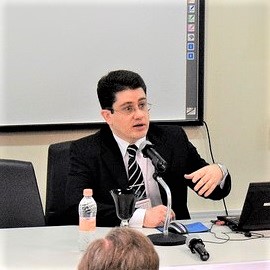
On April 27th, 2017, at Escola Politécnica da Universidade de São Paulo, occurred the first seminar from CEST (Society and Technology Study Center) on crowdsourcing, a collaborative business model used not only by large companies such as Google, Uber, Airbnb, and Netflix but also by Brazilian startups like Kickante and CrowdTest. Organized by researcher Eduardo Bertassi, the event brought four speakers who, from their visions and experiences, sought to show the concepts, obstacles, and particularities of this business model.
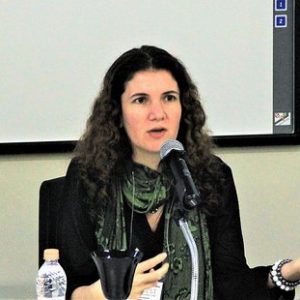
Marina Miranda, general director from the crowdsourcing consulting firm Mutopo Brasil, started the presentations by tracing a brief history of her experiences in the area. In 2008, she participated in the Teia MG project, which involved young people from deprived areas of the state in the collective learning of computing. She also spoke about the importance of holding the Campus Party event by introducing into the country a decentralized and hyperconnected information environment, which is one of the bases of crowdsourcing.
She pointed out some key factors for the crowdsourcing practice evolution such as globalization (which expanded connectivity and made available borderless human potential), mobile networks (which allowed crowdsourcing to be run from anywhere by using mobile phones), and the younger generations aspirations change (who seek a more flexible and diversified lifestyle, preferring resource sharing instead of owning them).
Through internet proposed “challenges” by companies such as Starbucks, the method was used to enable people from around the world to present not only projects but also solutions. “Social networks enable people to create projects,” she said, showing how the evolution through the use of the internet made it possible to popularize crowdfunding and other crowdsourcing initiatives. “The social issue is very compelling in humans, which is why crowdsourcing is rising”, she said.
Marina Miranda also drew attention to other subtle forms of crowdsourcing that are being carried out by prosumers, i.e., people who are no longer just internet’s content consumers but also internet’s content producers. According to her, “These people are producing content that will be sold, or just posted, by third parties and both content producers, and crowdsourcing platform owners end up having mutual benefits”; that is the case of companies such as iStockPhoto, Pinterest, Instagram, among others.
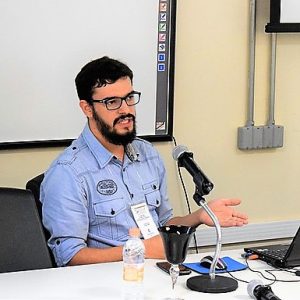
Daniel Souza, the co-founder of Broota Brazil (renamed to Kria in 2018), addressed one type of crowdfunding model less known in Brazil: the equity crowdsourcing. His company pioneered the implementation of a software platform in our country that enables regular people to invest in startups. The model is based on online investment rounds in which entrepreneurs can buy shares of a growing business, thus forming a more rapid, broad and affordable business network. “The crowdsourcing platform allows investors to contact a more significant number of startups with greater ease”, he said.
Daniel gave the audience an overview of the startups and investors that are currently active in the platform. The new companies belong to a variety of segments and usually target innovative products with high growth potential; 70% of the startups are located in the city of São Paulo. According to Daniel “In general, the standard investor profile is of a well graduated young male entrepreneur”. He also reiterated the need to educate the investors in this new logic of doing business; “Due to market instability and some other factors, only 20% of startups provide profitable returns of investment; therefore t is preferable to make smaller investments in a larger number of projects”.
In the first debate mediated by Thomas Eckshmidt, founder of the Conscious Capitalism Institute in Brazil, crowdsourcing could be considered as a technological evolution of mechanisms that already existed, such as popular juries and opinion polls of a modern society characterized by entrepreneurship.
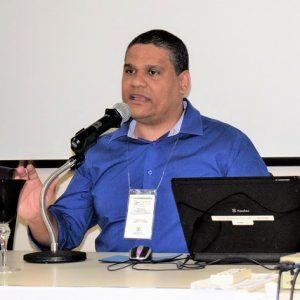
After a brief break, Robert Pereira, the co-founder of the company Base2, which created the software Crowdtask, talked about the software testing method based on crowdtesting. Crowdtesting focuses on the online communities effectiveness to evaluate software and electronic games and finding problems in them. Robert explained that “Crowdtesting allows a much larger number of people, with varying degrees of knowledge and skills, to participate in the testing phase of a system”. Also, according to him, “The people diversity is fundamental because it allows the emergence of test cases that would never be imagined by the developer’s team, which helps the system being implemented to be refined”.
In addition, Robert said that the crowdtesting model brings financial benefits by being less costly to companies and by speeding up the testing process. However, he explained why this is not the primary model employed by software companies, “It is more difficult to ensure the confidentiality of a project when working with large communities of testers”. According to him, testers end up evaluating particular aspects of the software, thus losing the whole idea of the system, “Not to mention that we cannot guarantee that the same testers will be working on the same project all the time, so the search for good testers must be continuous”.
For the future, Robert highlights that the challenges are to guarantee the testers’ qualification (until then, there is no standardized recruitment process for the people who participate in these test communities), to implement new payment models (besides the pay-per-bug, which pays for a problem identified in the software, and the pay-per-test, which pays for a test run), and to automate the testers recruitment and selection for specific software projects.
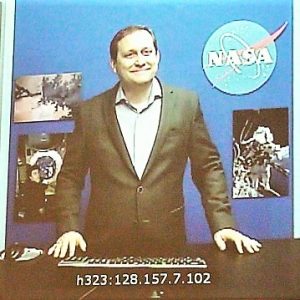
At the end of the event, Steven N. Rader, deputy manager of NASA’s Center for Excellence in Collaborative Innovation, attended the event through video conference. Rader explained how NASA has been using crowdsourcing to drive innovation. He says he knows that no company can have all the best minds in the world working in their teams – not even a reputed institution like NASA – so the use of crowdsourcing platforms allows the contact with different communities. Although there is a curatorial selection of participants, crowdsourced projects enable access to the expertise and knowledge of people outside of NASA. According to Rader, many of these people do not have specific skills that are necessary to some research fields of the projects, but they end up bringing new perspectives to the same situation or problem that no engineer might have thought.
He reports that NASA, through the promotion of online contests mediated by crowdsourcing platforms such as Topcoder, Innocentive, Grabcad, among others, employs this problem-solving model successfully. Rader said that NASA’s internal teams would take much longer to develop new algorithms and software or creating innovative designs. He highlighted that there exists a program called NASA@Work, which is NASA’s internal crowdsourcing platform that helps the integration of different teams from different departments to work on several internal projects.
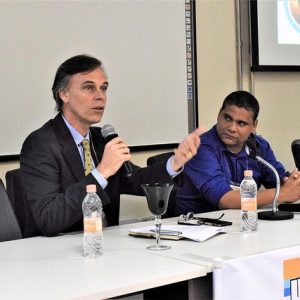
In the final debate mediated again by Thomas Eckschmidt, it was discussed how people could be attracted to contribute to crowdsourcing projects. For Steven Rader, “It is necessary to motivate users thought the challenge posed by the problem, incentivizing people not only with awards but with the feeling that the project is helping society somehow”. Concerning the diversity of user, Robert mentioned that “User diversity relies on the capacity of crowdsourcing companies state the problem in a clear and concise way so that the could be more comprehensive for a higher spectrum of users”.
To access the event material (presentations, photos, and videos), click here.
Text by Fredy Alexandrakis and Bárbara Reis (Jornalismo Júnior da USP)
Revised and translated by Eduardo Bertassi
 English
English Português
Português
